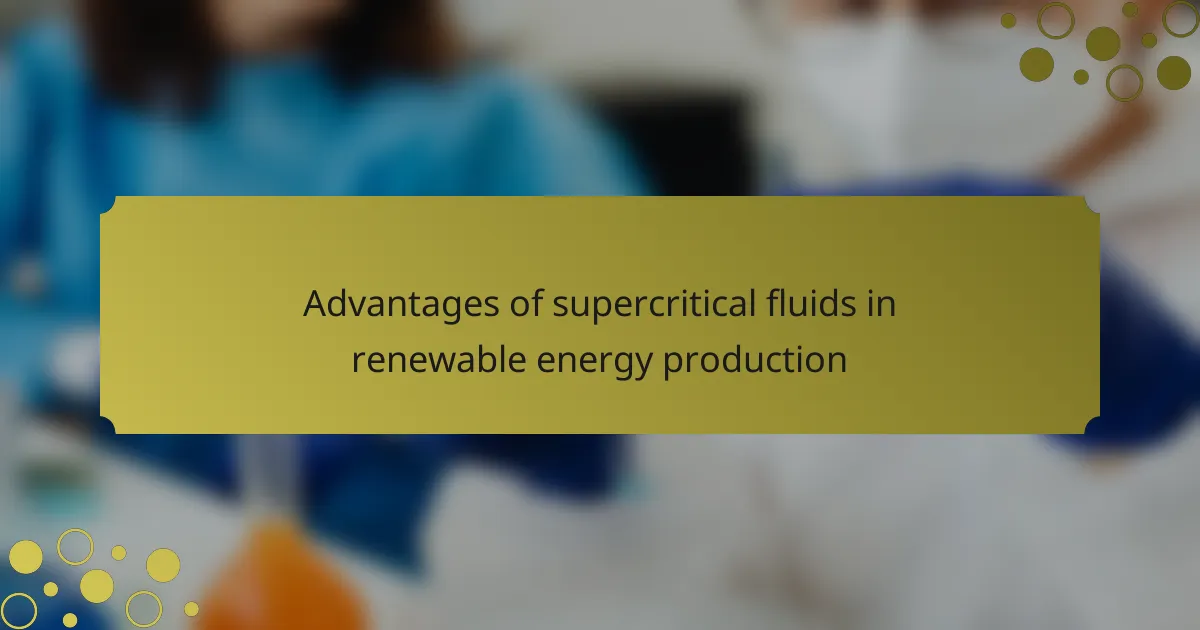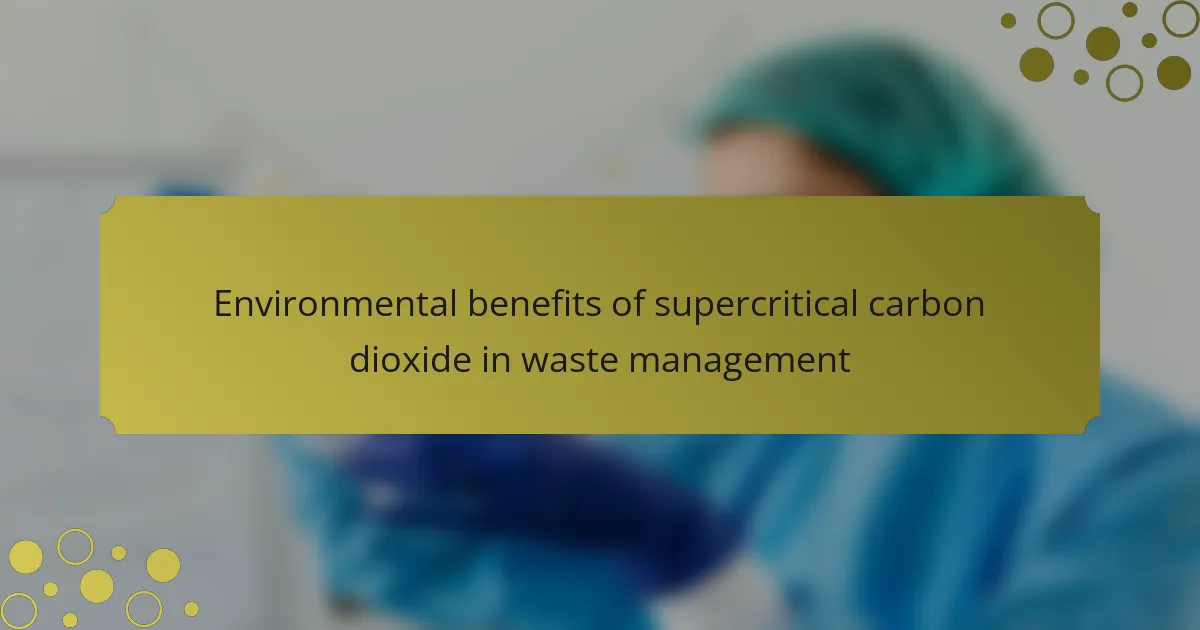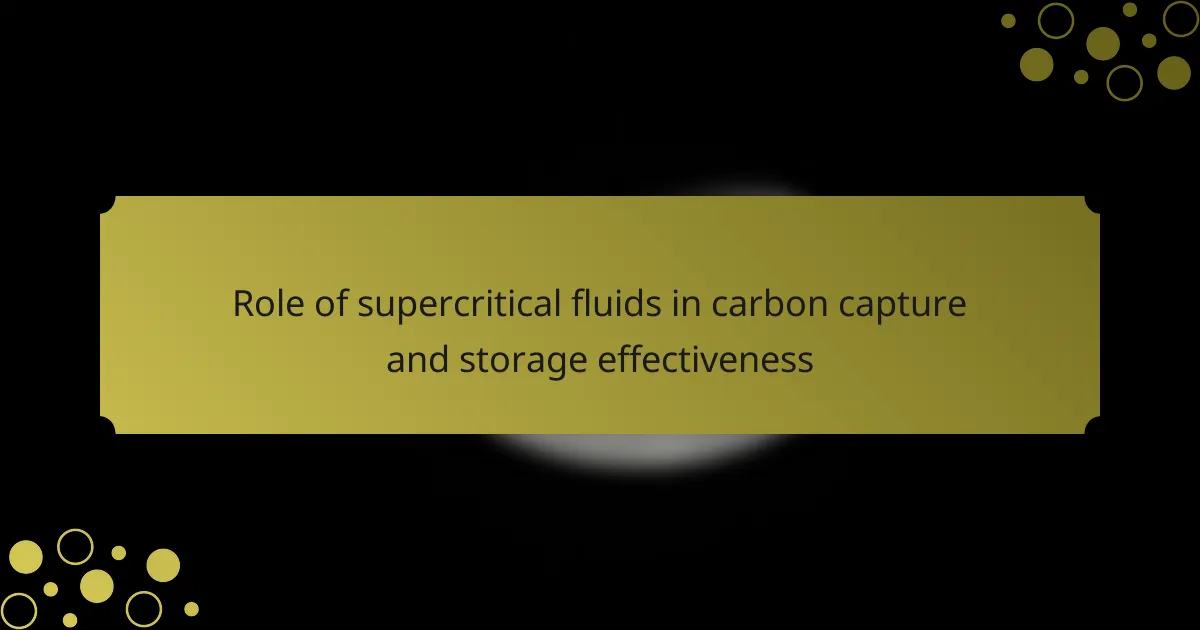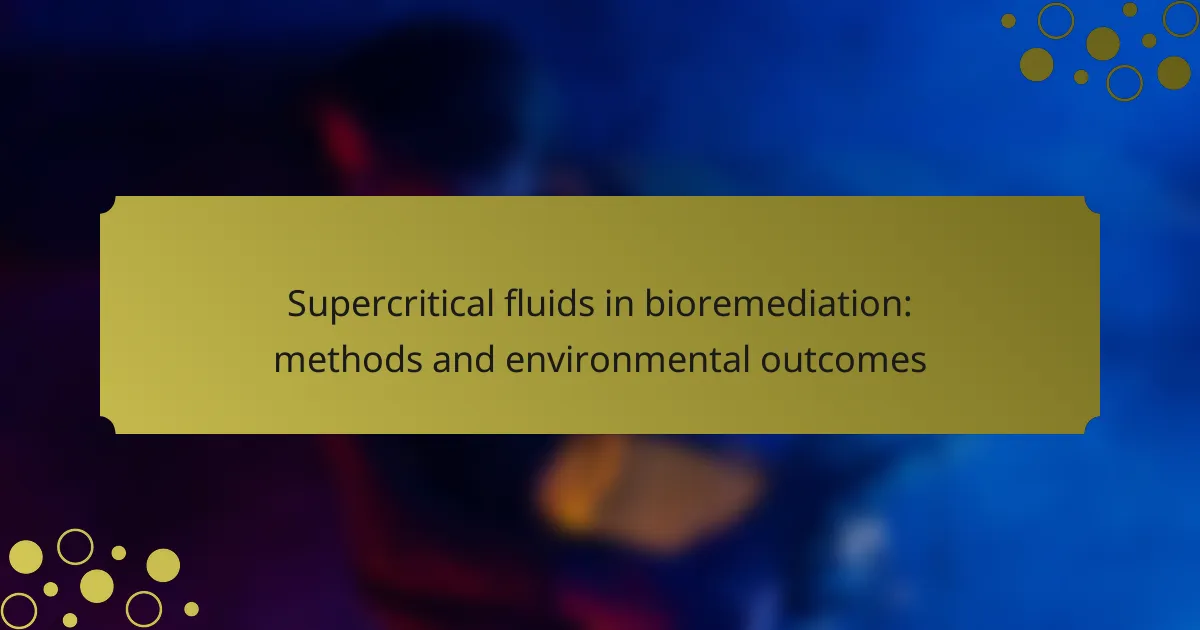Supercritical CO2 refers to carbon dioxide held at or above its critical temperature and pressure, allowing it to function as both a gas and a liquid. As a solvent, supercritical CO2 is effective for extracting a variety of compounds, particularly non-polar substances, due to its tunable density and solvating power. The use of supercritical CO2 is environmentally friendly, as it is non-toxic, leaves no harmful residues, and reduces reliance on organic solvents, making it an attractive option for sustainable product development. However, challenges such as limited solubility for polar compounds, high equipment costs, and safety concerns regarding high-pressure systems may hinder its widespread industrial application.
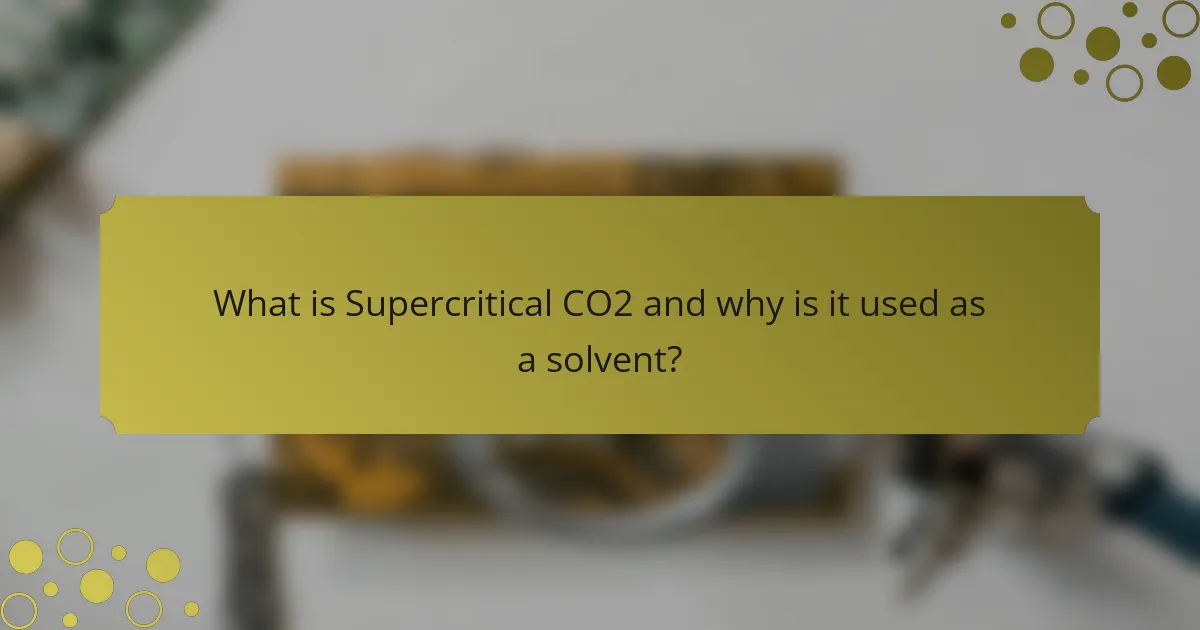
What is Supercritical CO2 and why is it used as a solvent?
Supercritical CO2 is carbon dioxide that is held at or above its critical temperature and pressure. This state allows it to exhibit properties of both a gas and a liquid. As a solvent, supercritical CO2 is effective for extracting compounds due to its tunable density and solvating power. It can dissolve a wide range of non-polar and some polar substances. Additionally, supercritical CO2 is environmentally friendly, as it is non-toxic and leaves no harmful residues. Its use reduces the need for organic solvents, aligning with sustainable practices in product development.
How does supercritical CO2 differ from traditional solvents?
Supercritical CO2 differs from traditional solvents in its unique state and properties. It exists at temperatures and pressures above its critical point, allowing it to behave like both a gas and a liquid. This dual behavior enables it to dissolve a wide range of compounds effectively. Traditional solvents, like water or organic solvents, do not exhibit this versatility. Supercritical CO2 has a low viscosity and high diffusivity, which enhances its ability to penetrate materials. Additionally, it is non-toxic and environmentally friendly, unlike many traditional solvents that can be hazardous. These properties make supercritical CO2 an ideal choice for eco-friendly product development.
What are the physical properties of supercritical CO2 that make it effective?
Supercritical CO2 has unique physical properties that make it an effective solvent. It exhibits low viscosity, allowing for better [censured] into materials. Its high diffusivity enhances the extraction efficiency of compounds. Supercritical CO2 has tunable density, enabling control over solubility. This property allows for selective extraction of desired substances. Additionally, supercritical CO2 is non-toxic and environmentally friendly. Its ability to dissolve both polar and non-polar compounds makes it versatile. These characteristics contribute to its effectiveness in eco-friendly product development.
Why is supercritical CO2 considered eco-friendly compared to other solvents?
Supercritical CO2 is considered eco-friendly compared to other solvents due to its non-toxic nature and low environmental impact. It is derived from a naturally occurring substance, carbon dioxide, which is abundant and inexpensive. Unlike traditional organic solvents, supercritical CO2 does not produce harmful volatile organic compounds (VOCs). This reduces air pollution and health risks associated with solvent exposure. Additionally, supercritical CO2 can be recycled in closed-loop systems, minimizing waste. Studies show that using supercritical CO2 in extraction processes significantly lowers the carbon footprint. Its efficiency in extracting valuable compounds further promotes sustainable practices in product development.
What are the applications of supercritical CO2 in product development?
Supercritical CO2 is used in product development for extraction, formulation, and cleaning processes. It serves as an eco-friendly solvent for extracting essential oils and flavors from plants. This method reduces the need for harmful organic solvents. Supercritical CO2 is also utilized in the production of pharmaceuticals. It aids in formulating drug delivery systems with enhanced bioavailability. Additionally, supercritical CO2 is effective in cleaning and degreasing equipment in manufacturing. Its application minimizes waste and environmental impact. Various industries, including food, cosmetics, and pharmaceuticals, leverage supercritical CO2 for sustainable product development.
How is supercritical CO2 used in the extraction of natural products?
Supercritical CO2 is used in the extraction of natural products as a solvent that efficiently dissolves compounds. It operates above its critical temperature and pressure, allowing it to exhibit properties of both gas and liquid. This unique state enhances its ability to extract essential oils, flavors, and bioactive compounds from plants. The process is environmentally friendly, as it avoids harmful solvents. Supercritical CO2 extraction preserves the integrity of sensitive compounds. Studies show it can selectively extract desired components while minimizing unwanted substances. This method is widely applied in food, cosmetic, and pharmaceutical industries for its efficiency and safety.
What role does supercritical CO2 play in the formulation of eco-friendly materials?
Supercritical CO2 serves as a sustainable solvent in the formulation of eco-friendly materials. It effectively replaces traditional organic solvents, reducing environmental impact. Supercritical CO2 has low toxicity and is non-flammable. It can dissolve a wide range of compounds, enabling efficient extraction and formulation processes. This method minimizes waste and energy consumption compared to conventional techniques. Research shows that using supercritical CO2 can enhance the properties of biodegradable materials. For instance, studies indicate improved mechanical strength and flexibility in biopolymers when processed with supercritical CO2. This demonstrates its significant role in the development of sustainable products.
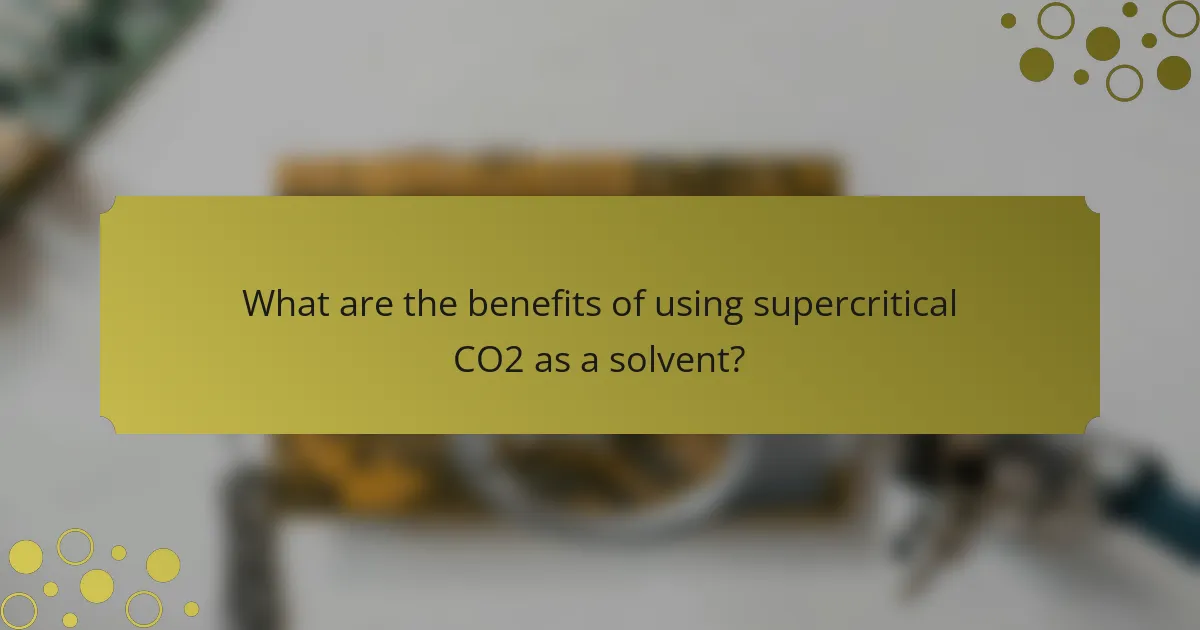
What are the benefits of using supercritical CO2 as a solvent?
Supercritical CO2 offers several benefits as a solvent. It is non-toxic and environmentally friendly. This makes it suitable for applications in eco-friendly product development. Supercritical CO2 has a tunable solvent power. This allows for selective extraction of desired compounds. Additionally, it evaporates completely, leaving no residue. Its low temperature processing preserves sensitive compounds. Supercritical CO2 also reduces the need for organic solvents. This minimizes hazardous waste and enhances safety in industrial processes.
How does supercritical CO2 enhance product quality?
Supercritical CO2 enhances product quality by acting as an efficient extraction solvent. It selectively extracts desired compounds while leaving behind impurities. This results in purer products with enhanced flavor and aroma profiles. Supercritical CO2 operates at lower temperatures, preserving heat-sensitive compounds. This method minimizes thermal degradation of sensitive ingredients. Additionally, it reduces the need for harmful organic solvents, promoting eco-friendliness. Studies show that products extracted with supercritical CO2 exhibit improved stability and shelf life. Overall, supercritical CO2 contributes to higher quality, safer, and more sustainable products.
What specific advantages does it offer in terms of purity and yield?
Supercritical CO2 offers significant advantages in terms of purity and yield. It acts as a selective solvent, effectively extracting desired compounds while minimizing impurities. This selectivity results in higher purity levels of the final product. Additionally, supercritical CO2 operates at low temperatures, preserving the integrity of heat-sensitive compounds. The extraction process can be finely tuned by adjusting pressure and temperature, optimizing yield. Studies indicate that supercritical CO2 extraction can achieve yields comparable to or exceeding traditional methods. For instance, research shows that it can extract up to 90% of active compounds from plant materials. This efficiency underscores its effectiveness in eco-friendly product development.
How does the use of supercritical CO2 impact production efficiency?
The use of supercritical CO2 significantly enhances production efficiency. It acts as an effective solvent that improves extraction rates. Supercritical CO2 can dissolve a wide range of compounds. This property allows for faster processing times. Additionally, it operates at lower temperatures compared to traditional solvents. This reduces energy consumption during production. Furthermore, supercritical CO2 is non-toxic and environmentally friendly. Its use minimizes waste and the need for hazardous chemicals. Studies show that processes utilizing supercritical CO2 can achieve higher yields with lower operational costs.
What environmental benefits are associated with supercritical CO2 usage?
Supercritical CO2 usage offers several environmental benefits. It serves as a non-toxic and non-flammable solvent. This reduces the risk of hazardous chemical exposure. Supercritical CO2 is also recyclable, minimizing waste production. Its application leads to lower energy consumption in extraction processes. Studies show that using supercritical CO2 can decrease greenhouse gas emissions. Furthermore, it can replace volatile organic compounds (VOCs) in various industrial processes. This transition contributes to improved air quality. Overall, supercritical CO2 usage supports sustainable practices in product development.
How does supercritical CO2 contribute to reducing chemical waste?
Supercritical CO2 reduces chemical waste by serving as a green solvent in various processes. It replaces traditional organic solvents that often generate harmful byproducts. Supercritical CO2 is non-toxic and recyclable, minimizing environmental impact. Its use in extraction processes, such as decaffeination of coffee, produces fewer waste materials. Research shows that using supercritical CO2 can lead to up to 90% reduction in solvent waste compared to conventional methods. This makes it a sustainable alternative in industries like pharmaceuticals and food processing. Overall, supercritical CO2 contributes significantly to waste reduction and eco-friendly practices.
What are the implications for sustainability in various industries?
Sustainability implications in various industries include reduced environmental impact and improved resource efficiency. Supercritical CO2 as a solvent minimizes hazardous waste generation. It replaces toxic solvents commonly used in extraction processes. This shift leads to cleaner production methods. Additionally, supercritical CO2 enhances energy efficiency in manufacturing. Industries such as pharmaceuticals and food benefit from lower energy consumption. Research shows that using supercritical CO2 can decrease greenhouse gas emissions significantly. For instance, a study by McHugh and Krukonis highlights its effectiveness in reducing solvent-related pollution. Overall, adopting supercritical CO2 contributes positively to sustainable practices across multiple sectors.
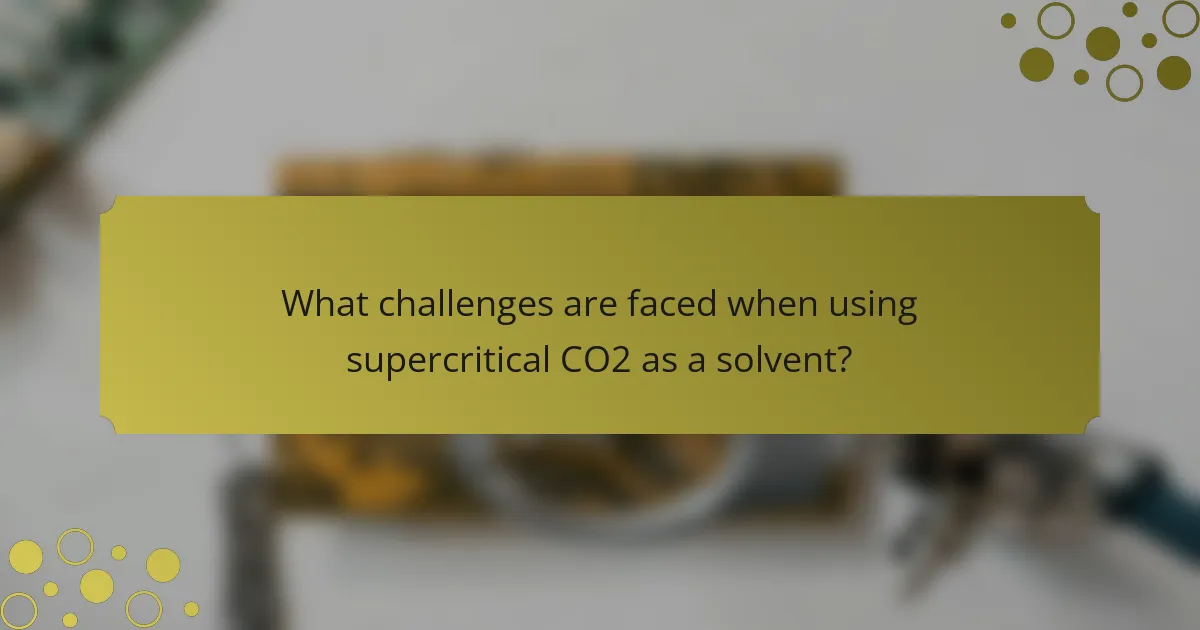
What challenges are faced when using supercritical CO2 as a solvent?
Supercritical CO2 presents several challenges as a solvent. One major challenge is its limited solvent power for polar compounds. Many organic compounds do not dissolve well in supercritical CO2. This reduces its effectiveness for certain applications. Another challenge is maintaining the high pressure and temperature required for supercritical conditions. This can lead to increased equipment costs and complexity. Additionally, the extraction process may require co-solvents to enhance solubility. These co-solvents can undermine the eco-friendly benefits of using supercritical CO2. Furthermore, the scalability of supercritical CO2 processes can be difficult. This limits its adoption in large-scale industrial applications. Lastly, there are safety concerns related to high-pressure systems. These factors collectively hinder the widespread use of supercritical CO2 as a solvent.
What are the technical limitations of supercritical CO2 in product development?
Supercritical CO2 has several technical limitations in product development. One limitation is its low polarity, which restricts its ability to dissolve polar compounds effectively. This limits its application in extracting certain bioactive compounds. Another limitation is the requirement for high pressure and temperature, which can complicate equipment design and increase operational costs. Additionally, supercritical CO2 may not provide sufficient selectivity for certain target compounds, leading to impurities in the final product. Its low viscosity can also hinder mass transfer rates, affecting extraction efficiency. These factors can impact the scalability and economic viability of processes utilizing supercritical CO2.
How do pressure and temperature conditions affect the process?
Pressure and temperature conditions significantly influence the process of using supercritical CO2 as a solvent. Supercritical CO2 operates at high pressure and temperature, typically above 73.8 bar and 31.1°C. These conditions allow CO2 to exhibit properties of both gases and liquids, enhancing its solvating capabilities. Increased pressure raises the density of supercritical CO2, improving its ability to dissolve various compounds. Higher temperatures can increase the solubility of certain materials, allowing for more efficient extraction. Research indicates that adjusting these parameters can optimize extraction yields and improve product quality. For instance, a study by C. A. M. van der Waal et al. (2019) demonstrated that varying pressure and temperature can enhance the extraction efficiency of bioactive compounds from plant materials.
What are the economic considerations involved in implementing supercritical CO2 technology?
The economic considerations involved in implementing supercritical CO2 technology include initial investment costs, operational expenses, and potential return on investment. Initial costs encompass equipment, installation, and technology development. For instance, supercritical CO2 systems can require significant capital for high-pressure vessels and compressors. Operational expenses involve energy consumption and maintenance. The efficiency of supercritical CO2 processes can lead to lower solvent recovery costs compared to traditional methods. Furthermore, potential savings from reduced waste disposal and environmental compliance can enhance profitability. Market demand for eco-friendly products can also drive revenue growth, making supercritical CO2 technology economically attractive.
How can these challenges be addressed?
Challenges in using supercritical CO2 as a solvent can be addressed through several strategies. First, optimizing extraction parameters can improve efficiency and yield. Adjusting temperature and pressure can enhance the solubility of target compounds. Second, incorporating co-solvents can broaden the range of extractable substances. This approach can increase the effectiveness of supercritical CO2 in various applications. Third, investing in research and development can lead to innovative technologies. This can help overcome limitations associated with supercritical CO2 systems. Lastly, educating industries about the benefits and applications of supercritical CO2 can promote its adoption. Increased awareness can lead to more widespread use in eco-friendly product development.
What advancements are being made to improve supercritical CO2 processes?
Advancements in supercritical CO2 processes focus on enhancing efficiency and reducing costs. Researchers are developing new extraction techniques that optimize solubility and selectivity. Innovations include the use of co-solvents to improve extraction yields. Advanced process control technologies are also being implemented to monitor and adjust conditions in real-time. Studies show these methods can increase extraction rates by up to 30%. Additionally, improvements in reactor design are being explored to facilitate continuous processing. These advancements contribute to the overall sustainability and scalability of supercritical CO2 applications.
What best practices should be followed to optimize the use of supercritical CO2?
To optimize the use of supercritical CO2, maintain precise control over temperature and pressure. Supercritical CO2 operates effectively at temperatures between 31°C and 80°C and pressures from 74 to 300 bar. Adjusting these parameters can enhance solubility and extraction efficiency. Use appropriate co-solvents to improve solubility for specific compounds. Ethanol or methanol can be effective in certain applications. Implement efficient recovery systems to recycle CO2, reducing costs and environmental impact. Regularly monitor system performance to ensure optimal operation and identify potential issues. Conduct thorough training for operators to ensure safety and efficiency in handling supercritical CO2 systems.
What practical tips can be applied when using supercritical CO2 in product development?
Use supercritical CO2 carefully to optimize extraction processes. Maintain precise temperature and pressure controls for effective solvation. Ensure proper selection of co-solvents to enhance solubility for specific compounds. Conduct small-scale trials to evaluate extraction efficiency before scaling up. Monitor the system for any phase separation or instability during the process. Utilize appropriate materials resistant to supercritical CO2 to prevent equipment degradation. Implement safety protocols to manage high-pressure conditions effectively. Consider the environmental impact and regulatory compliance throughout the development process.
Supercritical CO2 is a carbon dioxide state that combines properties of both gas and liquid, making it an effective solvent for eco-friendly product development. This article explores the unique attributes of supercritical CO2, including its non-toxic nature, tunable density, and ability to dissolve a wide range of compounds, which contribute to its role in sustainable practices. Key applications in extraction, formulation, and cleaning across various industries are highlighted, along with the environmental benefits and challenges associated with its use. The discussion also addresses technical limitations, economic considerations, and advancements aimed at optimizing supercritical CO2 processes for enhanced efficiency and reduced waste.
